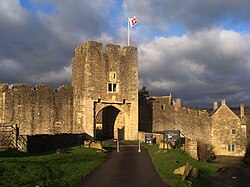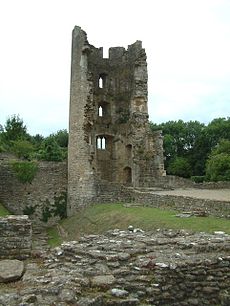Farleigh Hungerford Castle
| Farleigh Hungerford Castle | |
|
Somerset | |
|---|---|
 Eastern gatehouse of Farleigh Hungerford Castle | |
| Type: | Quadrangular castle |
| Location | |
| Grid reference: | Expression error: Unexpected < operator.&y=Expression error: Unexpected < operator.&z=120 ST8005762 |
| Location: | 51°19’0"N, 2°17’13"W |
| History | |
| Key events: | Civil War |
| Information | |
| Condition: | Ruined |
| Owned by: | English Heritage |
| Website: | Farleigh Hungerford Castle |
Farleigh Hungerford Castle, sometimes called Farleigh Castle or Farley Castle, is a mediæval castle in Farleigh Hungerford in Somerset.
The castle was built in two phases: the inner court was constructed between 1377 and 1383 by Sir Thomas Hungerford, who made his fortune working as a steward to John of Gaunt Duke of Lancaster. The castle was built to a quadrangular design, already slightly old-fashioned, on the site of an existing manor house overlooking the River Frome. A park was attached to the castle, requiring the destruction of a local village. His son, Sir Walter Hungerford, a successful knight and courtier to King Henry V, became rich during the Hundred Years War with France and extended the castle with an additional, outer court, enclosing the parish church in the process. By Walter's death in 1449, the substantial castle was richly appointed and its chapel decorated with murals.
The castle largely remained in the hands of the Hungerford family over the next two centuries, despite periods during the War of the Roses in which it was held by the Crown following the attainder and execution of members of the family.
At the outbreak of the Civil War in 1642, the castle, modernized to the latest Tudor and Stuart fashions, was held by Sir Edward Hungerford. Edward declared his support for Parliament, becoming a leader of the Roundheads in Wiltshire. Farleigh Hungerford was seized by Royalist forces in 1643, but recaptured by Parliament without a fight near the end of the conflict in 1645. As a result, it escaped slighting following the war, unlike many other castles in the south-west of England.
The last member of the Hungerford family to hold the castle, Sir Edward Hungerford, inherited it in 1657, but his gambling and expensive living forced him to sell the property in 1686. By the 18th century the castle was no longer lived in by its owners and fell into disrepair; in 1730 it was bought by the Houlton family, when much of it was broken up for salvage. Antiquarian and tourist interest in the now ruined castle increased through the 18th and 19th centuries. The castle chapel was repaired in 1779 and became a museum of curiosities, complete with the murals rediscovered on its walls in 1844 and a number of rare lead anthropomorphic coffins from the mid-17th century.
In the 1915 Farleigh Hungerford Castle was sold to the Office of Works and a controversial restoration programme began. It is now owned by English Heritage, who operate it as a tourist attraction, and the castle is a Grade I listed building and a Scheduled Ancient Monument.
The castle today
Today, most of Farleigh Hungerford Castle is ruined. In the inner court only the exposed foundations remain of most of the castle buildings, along with the shells of the south-west and south-east towers.[1] Unusually for English castles, the outer court has survived better than the inner.[1] The restored eastern gatehouse is carved with the badge of the Hungerfords and the initials of the first Sir Edward Hungerford, who had them carved there between 1516 and 1522.[2] The priest's house remains intact, measuring 39 feet by 22 feet with two rooms on the ground floor and four rooms above.[3]
In Saint Leonard's Chapel, the outlines of many of the mediæval murals can still be made out, with the painting of Saint George and Dragon still in particularly good condition — historian Simon Roffey describes this work, one of only four such surviving works, as "remarkable".[4][5] The late 17th century tombs of the Hungerfords remain intact in the north transept chapel dedicated to St Anne. The surviving lead anthropomorphic coffins in the crypt are archaeologically significant: although numerous in the late 16th and 17th centuries, few lead coffins survive today and Farleigh Hungerford Castle has what historian Charles Kightly considers "the best collection" in the country.[6]
The castle site is run by English Heritage as a tourist attraction. It is a Scheduled Monument and a Grade I listed building.
Pictures
Outside links
| ("Wikimedia Commons" has material about Farleigh Hungerford Castle) |
- Farleigh Hungerford Castle – English Heritage
References
- ↑ 1.0 1.1 Pettifer, p.221.
- ↑ Kightly, Charles Farleigh Hungerford Castle. page 11 (English Heritage, 2006) ISBN 1-85074-997-3
- ↑ Priest's house, Farleigh Castle, Farleigh Hungerford, Somerset Historic Environment Record
- ↑ Roffey, p.73
- ↑ National Monuments Record: No. 207732 – Farleigh Castle, Hungerford
- ↑ Kightly, Charles Farleigh Hungerford Castle. page 15 (English Heritage, 2006) ISBN 1-85074-997-3
Books
- Aston, M. (ed) (1998) Aspects of the Mediæval Landscape of Somerset and Contributions to the Landscape History of the County. Taunton, UK: Somerset County Council. ISBN 978-0-86183-129-6.
- Bettey, Joseph. (1998) "From the Norman Conquest to the Reformation", in Aston (ed) (1998).
- Bull, Henry. (1859) A History, Military and Municipal, of the Ancient Borough of Devizes. London: Longman. OCLC 23280770.
- Creighton, Oliver Hamilton. (2005) Castles and Landscapes: Power, Community and Fortification in Mediæval England. London: Equinox. ISBN 978-1-904768-67-8.
- Creighton, Oliver Hamilton and Robert Higham. (2003) Mediæval Castles. Princes Risborough, UK: Shire Publications. ISBN 978-0-7478-0546-5.
- Cruickshanks, Eveline and Stuart Handley (eds) (2002) The House of Commons: 1690-1715. Cambridge: Cambridge University Press. ISBN 978-0-521-77221-1.
- Emery, Anthony. (2006) Greater Mediæval Houses of England and Wales, 1300–1500: Southern England. Cambridge: Cambridge University Press. ISBN 978-0-521-58132-5.
- Given-Wilson, Chris. (1996) The English Nobility in the Late Middle Ages. London: Routledge. ISBN 978-0-203-44126-8.
- Gondoin, Stéphane W. (2005) Châteaux-Forts: Assiéger et Fortifier au Moyen Âge. Paris: Cheminements. ISBN 978-2-84478-395-0. (in French)
- Hall, Hubert. (2003) Society in the Elizabethan Age. Whitefish, US: Kessinger Publishing. ISBN 978-0-7661-3974-9.
- Hayton, D. W. and Henry Lancaster. (2002) "Sir Edward Hungerford", in Cruickshanks and Handley (eds) (2002).
- Jackson, J. E. (1851) "Farleigh Hungerford Castle, Somerset", Proceedings of Somerset Archaeology 1-3 pp. 114–124.
- Kightly, Charles. (2006) Farleigh Hungerford Castle London: English Heritage. ISBN 1-85074-997-3.
- Mackenzie, James D. (1896) The Castles of England: Their Story and Structure, Vol II. New York: Macmillan. OCLC 504892038.
- Miles, T. J and A. D. Saunders. (1975) "The Chantry House at Farleigh Hungerford Castle", Mediæval Archaeology 19, pp. 165–94.
- Murphy, Ignatius Ingoldsby. (1891) Life of Colonel Daniel E. Hungerford. Hartford, US: Case, Lockwood and Brainard. OCLC 10269342.
- Pettifer, Adrian. (2002) English Castles: a Guide by Counties. Woodbridge, UK: Boydell Press. ISBN 978-0-85115-782-5.
- Pounds, Norman John Greville. (1994) The Mediæval Castle in England and Wales: a Social and Political History. Cambridge: Cambridge University Press. ISBN 978-0-521-45828-3.
- Roffey, Simon. (2007) The Mediæval Chantry Chapel: an Archaeology. Woodbridge, UK: Boydell Press. ISBN 978-1-84383-334-5.
- Tarlow, Sarah. (2011) Ritual, Belief and the Dead in Early Modern Britain and Ireland. Cambridge: Cambridge University Press. ISBN 978-0-521-76154-3.
- Wade, G. W. and J. H. Wade. (1929) Somerset. London: Methuen. OCLC 601718264.
- Wilcox, Ronald. (1981). "Excavations at Farleigh Hungerford Castle, Somerset, 1973-6", Proceedings of Somerset Archaeology 124, pp. 87–109







